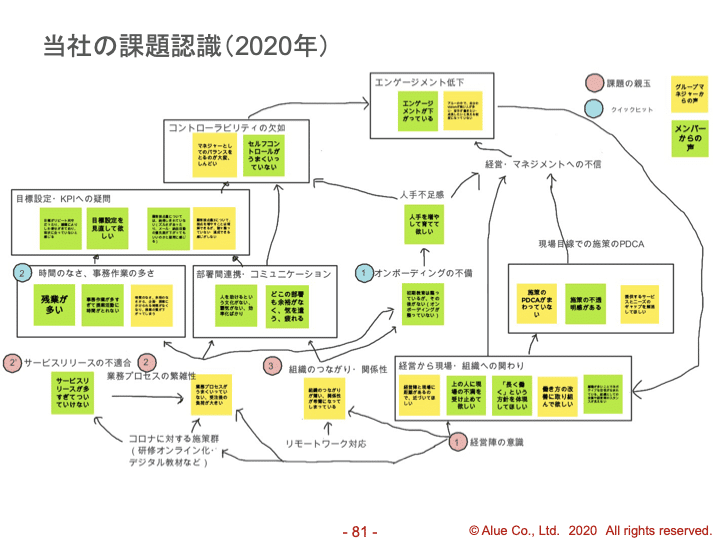
その問題意識に「問い」はあるか?
前回の記事では、「改善・イノベーション」の章の始まりとして、「意図して変化していくこと(変化しないこと)」の大切さについてお話ししました。今回は、改善やイノベーションにおける問いの大切さについてお話しします。
改善とイノベーションの関係
まず、改善とイノベーションという言葉が並んでいることに違和感をもたれる方もいらっしゃるかもしれませんので、この二つの扱いについて簡単にお話しします。
結論からお伝えしますと、意識の意識化の観点からは、本質的には同じことと捉えています。今後の記事で詳しくお伝えしますが、「意図した変化を起こしていくこと」という観点では同じであり、「どのレベルまで深堀りして、変化を起こしていくか」が違うだけであると捉えています。
それぞれの言葉の定義を示します。
改善の定義(落合の考え)
メタ的(多次元・多角的)に事象の構造・背景を捉え、同時に真に「ありたい姿」も捉えた上で、改善ストーリーを導出し、決断すること
イノベーションの定義(落合の考え)
「ありたい姿」の実現に向けて、具現化と理念化の往復運動を繰り返し、チームで高速で改善することによって現状から発展した姿を結晶化させること
どちらの定義も、「ありたい姿(ヴィジョンなど)」に向けて、現状から意図的に変化を起こすことについては同じですね。本章においては、特段の区別がない場合は、改善とイノベーションについては、同列に扱っていきます。

漠然とした課題意識と「問い」の違い
将来のありたい姿を捉えた上で、現状とのギャップを的確に認識し、意図をもって「どう変わるか?」に向き合うのが、改善・イノベーションです。
変化を起こすためには、自ら変わろうとしなければ始まりません。何も意識せずにいると、今までやってきたことを維持するマインドになりやすいものです。
では、変わろうとするとは、具体的にどうすることでしょうか?
改善・イノベーションは、最初のステップである「問い」をいかに適切に立てられるかにかかっていると私は思います。
なぜなら、「問い」は、その人が何を課題と捉えているか、何を変えなければいけないと認識しているか、さらに言えば、どのような願いを持っているかを表すものだからです。
うまく変われないパターンとしては、問いの立て方が適切でない場合もあれば、そもそも問い自体が立っていない場合もあります。すなわち、何を解決するべきかの認識が間違っている、あるいは、何を解決すべきか特定されていない、ということです。
逆に、問いがきちんと立てられれば、改善・イノベーションのプロセスは自然に回り始める、と言っても過言ではありません。
私自身、「今、自分はどのような問いをもっているか?」ということを自問します。このように自問することで、漠然とした課題意識に光を当てることでき、それを問いに変換することができます。
また、私は当社の役員・部長の方々と定期的に1on1をしていますが、私からよく尋ねる質問は「いま、どのような問いがたっていますか?」というものです。この質問は、役員・部長の方々がもっている課題意識を共有してもらうと共に、ご本人の中での漠然とした課題意識を問いに変換することに役立っています。

「課題の親玉」に対する問いを立てられるか?
「問い」を立てることの難しさについて、当社の課題を例にお伝えします。
当社では法人向けの社員育成サービスを提供していますが、感染症拡大をきっかけに、オフラインでの実施が難しくなったため、一気にサービスのオンライン化を進めました。そのスピード感はよかったのですが、業務が増えた上に業務プロセスが複雑になったことで、現場の疲弊感や、新規入社者のオンボーディングの難しさなど、様々な問題が表出していました。
問題の背景を探っていくと、様々な要素が複雑に絡まり合っていることがわかってきました。それを整理したのが次の図です。
(中身を細かく見ていただく必要はありません。課題の複雑さをご理解いただければ大丈夫です)

このような整理においては「課題の親玉」、つまり根本的な課題を見つけることが重要です。「課題の親玉」を解決できなければ、同じような問題が繰り返し起きてしまうからです。
この図では、赤い印をつけているのが「課題の親玉」です。具体的には「経営陣の意識」のように、企業文化や風土の根幹にかかわるものを「課題の親玉」としています。
このとき、たとえば、このケースにおいて「低下したエンゲージメントを改善するには?」のように、原因と結果の関係において結果に近い課題に対する問いを立ててしまうと、対処療法の施策しか発想できません。
上司と部下の面談の機会を増やしたり、社員同士の交流が活性化するイベントを実施したりすれば、エンゲージメントのスコアは上がるかもしれません。
しかしこれでは「課題の親玉」には全くアプローチできておらず、問題が根本解決しません。さらに言えば、仮にエンゲージメントのスコアが上がるという成果が出てしまうことで、「課題の親玉」に気付く機会を逃してしまうリスクもあります。
ここで注意が必要なのは、エンゲージメントがどんな場合においても結果的な課題であるという話ではありませんし、結果的な課題であるからといって重要ではないという話でもありません。(実際に、エンゲージメントは、当社にとって重要課題の一つです。)あくまでも、因果関係において、どちらがより根幹の原因に近いもので、どちらが結果に近いものかという話になります。
このケースの場合、「課題の親玉にアプローチする問い」は、「経営陣の意識をどう変えるべきか?」といったものになります(他にもあります)。経営陣の意識のあり方が、いろいろな意思決定を生み出し、その意思決定が結果を生み出していくという因果関係があるので、課題の親玉の一つとして、経営陣の意識を挙げています。
「問い」の立て方によって、解決策の内容もインパクトも全く変わってきます。

「問い」とは、モノの見方である
さらに重要なのは、その人の「見えている範囲」によって、問いは変わるということです。
物事の表層しか見えていない場合は表層的な問いになりますし、深層まで見えている場合はより根本的な問いが出てきます。そもそも「経営陣の意識に根本的な課題があるかもしれない」という見方をしていなければ、「経営陣の意識をどう変えるべきか?」という問いが出てくることはありません。
つまり、改善・イノベーションにおいては、それに携わる人のモノの見方が問われているのです。

そして、このモノの見方というのは、課題となっている事象を具体的に見たことがあるかどうかという具体レベルの話だけではなく、その課題と背景となっている構造や因果関係という必ずしも目に見えないものを認識しようとしているか、あるいは、そのような構造や因果関係を生み出す関係者の考え方や価値観という目に見えないものを捉えようとしているかということが問われます。
このような意味でも、「どのような問いをもっているか?」ということを自問したり、自分が所属するチームの中で共有したりすることは有意義であると思います。自分(たち)のモノの見方を自己客観視することができるからです。
今回の記事では、改善・イノベーションの始まりは問いを持つことであるということ、そして、問いとはモノの見方であるということをお話ししました。次回からは、モノの見方という観点から、改善・イノベーションについて深めていきます。
本日の問いとなります。(よろしければ、コメントにご意見ください)
・あなたは、今、どのような問いを持っていますか?(複数あっても構いません)
・上記の問いの背景として、あなたにはどのような願いがありますか?
Is there a "quest" for the problem?
In my previous article, as the beginning of the chapter on Improvement and Innovation, I talked about the importance of changing (or not changing) with intention. In this article, I would like to talk about the importance of quests(questions) in improvement and innovation.
The relationship between improvement and innovation
First of all, some of you may find the words "improvement" and "innovation" side by side uncomfortable, so I will briefly discuss the relationship between the two.
To tell you the conclusion first, from the perspective of ISHIKI(consciousness) management, I see it as essentially the same thing. I will tell you more about it in a future article, but I see it as the same in terms of "making the intended change", and the only difference is "what level of depth to go into and make the change".
Here are my definitions of each word.
Definition of improvement (Ochiai's idea)
Grasping the structure and background of events from a meta (multi-dimensional, multi-faceted) perspective, and at the same time grasping the true "ideal state" of things, then deriving an improvement story and making a decision.
Definition of innovation (Ochiai's idea)
To crystallize an image that has evolved from the current situation by repeating back and forth motions of embodiment and idealization, and by making improvements at high speed in a team in order to realize the "ideal state.
Both definitions are the same when it comes to intentionally making changes from the current situation toward the "desired state (vision, etc.). In this chapter, unless there is a special distinction, improvement and innovation will be treated in the same category.
The difference between a vague awareness of a problem and a "quest(question)"
Improvement and innovation is the process of accurately recognizing the gap between the current situation and what we want to be in the future, and deliberately addressing the question, "How can we change?”
In order to make a change, we have to try to change by ourselves. If we are not conscious of what we are doing, it is easy to maintain the same mindset that we have already had.
So what exactly does it mean to try to change?
In my opinion, improvement and innovation depends on how well we can formulate the first step, the "quest(question)."
This is because the "quest(question)" is an expression of what a person sees as a challenge, what he or she perceives needs to be changed, and more importantly, what he or she wishes to do.
The pattern of not being able to successfully change is that the quest(question) is not properly formulated, or the quest(question) itself is not formulated in the first place. In other words, the perception of what needs to be solved is wrong, or what needs to be solved is not specified.
On the other hand, it is not an exaggeration to say that if the quest(question) is formulated properly, the process of improvement and innovation will start to go naturally.
I sometimes ask myself, "What questions do I have now?" By asking myself this question, I am able to shed light on my vague awareness of problems and convert it into a quest(question).
In addition, I have regular 1-on-1 meetings with our executives and managers, and one of the questions I often ask is, "What quests(questions) do you have right now?" This question helps the executives and managers to share their awareness of problems and to convert them into clear quests(questions.)
Can we formulate a question for "the King of Problems?"
I will explain how difficult it is to formulate quests(questions), using our company's challenges as an example.
Our company provides employee training services for corporations, and in the wake of the spread of infectious diseases, it became difficult to implement these services offline, so we quickly moved our services online. Although the speed of the move was good, the increase in workload and the complexity of the business process brought out various problems such as exhaustion of the frontline and difficulty in onboarding new employees.
As we explored the background of the problem, we found out that it was a complex combination of various factors. The following diagram summarizes this.
(You do not need to look at the contents in detail. (You don't need to look at the contents in detail, just understanding the complexity is fine.)

In this kind of analysis, it is important to find the "king of issues," namely the fundamental issue. If the "king of issues" is not solved, the same problems will occur again and again.
In this diagram, the "kings of issues" are marked in red. The "kings of issues" are those related to the fundamentals of corporate culture, such as " consciousness of the management team.
In this case, for example, if we have quests(questions) about issues that are close to the result in the cause and effect relationship, for example, "How can we improve the declining engagement?," we will only be able to come up with coping superficial problems.
Increasing opportunities for meetings between supervisors and subordinates, or holding events that stimulate interaction between employees, may increase the engagement score.
However, this is not approaching the "king of issues" at all and does not solve the problem at its root. Moreover, there is a risk of missing the opportunity to discover the "king of issues" if the results of the engagement score increase.
It is important to note that we are not talking about engagement being a consequential issue in any case, nor are we talking about it not being important just because it is a consequential issue. (In fact, engagement is one of the key issues for our company.) We are only talking about which is closer to the root cause and which is closer to the result in terms of causality.
In this case, the question to approach the king of problems is: "How should we change the mindset of the management team?" (and there are other questions). Since there is a cause-and-effect relationship between the mindset of the management team and the various decisions they make, which in turn produce the results, I have listed the mindset of the management team as one of the kings of issues.
Depending on how we formulate the "quest(question)," the content and impact of the solution will be completely different.
A quest(question) is a way of looking at things
More importantly, quests(questions) will vary depending on the person's perspective of how far and how deep they can see.
If one can only see the surface of things, the questions will be superficial, and if one can see to the depths, the questions will be more fundamental. If we don't see that the fundamental issue may be in the mindset of the management team in the first place, we will not be able to ask "how to change the mindset of the management team."
In other words, in improvement and innovation, the way of looking at things of those who are involved in it is being challenged.
And this way of looking at things is not just about whether or not we have seen the issue in concrete terms, but also whether or not we are trying to recognize the structure and cause-and-effect relationships that form the background to the issue, which are not necessarily visible, or whether or not we are trying to capture the thinking and values of the people involved in creating such structures and cause-and-effect relationships, which are not necessarily visible either.
In this sense, I think it is meaningful to ask ourselves what kind of quests(questions) we have and to share them with the team we belong to. This is because it allows us to look at our own (our) way of looking at things objectively.
In this article, I talked about the beginning of improvement and innovation is to have a quest(question), and the quest(question) refers to the way we look at things. In the next article, we will deepen our understanding of improvement and innovation from the perspective of how we see things.
Here are the quests of the day. (If you'd like, please share your thoughts in the comments.)
・What kind of quests(questions) do you have now? (More than one is fine)
・In the background of the above quests(questions), what kind of wishes do you have?
Bunshiro Ochiai
この記事が気に入ったらサポートをしてみませんか?
